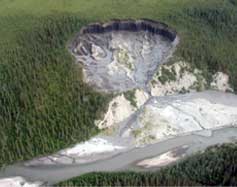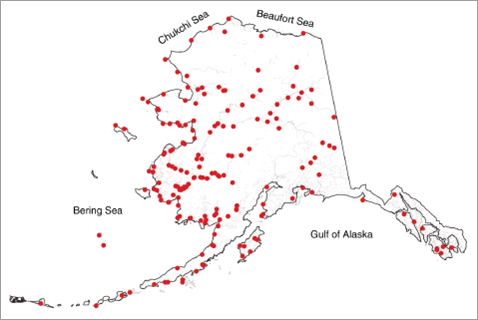Topics - Alaska
Alaska
Erosion & Flooding

Most villages in Alaska rely heavily on marine and freshwater species for their subsistence lifestyle. Salmon, whales, walruses, and seals all contribute to the rural Alaskan diet. Naturally, many Alaskan villages are situated close to surface-water sources, including rivers, streams, and lakes, as well as Alaska’s approximately 44,000 miles of coastline. This thin edge separating land from sea houses a majority of the state’s population. As the earth continues to warm, some of these coastal areas are experiencing increased erosion and flooding.
According to the United States Government Accountability Office (GAO), formerly known as the General Accounting Office, 86% (or 184 of 213) of Alaskan villages suffer from erosion and/or flooding. Although these villages have long suffered from such naturally occurring adversities, rising temperatures are in part to blame for the increasing severity. Four of these villages, including Kivalina and Shishmaref in the northwestern part of Alaska, are considered to be in “imminent danger” and will have to be relocated.
The major obstacle in relocating a village in remote parts of Alaska is the lack of financial resources. In villages that cannot even afford adequate waste-disposal systems, the idea of funding a complete relocation may seem unrealistic. One estimate puts the relocation cost at $60 million.
The Federal Government has increased its awareness of this issue, and although programs are available (through the Federal Emergency Management Agency, Housing and Urban Development, and the Department of Transportation) for disaster relief, the total funding needed for an undertaking of this type and size is not available by any conventional means.
A few villages have begun to take measures into their own hands with the construction of seawalls and barriers, and they’re also conducting studies pertaining to the flooding of specific infrastructure (i.e., runways and evacuation roads in Point Hope) and methods for mitigating those impacts.

Sources:
State of Alaska Department of Natural Resources. (2006). Alaska Coastal Management Program. March 26, 2008 at: www.alaskacoast.state.ak.us/Explore/Tourintro.html.
CONNECT WITH US
Nikki Cooley
Co-Director
Nikki.Cooley@nau.edu
Karen Cozzetto
Manager
Karen.Cozzetto@nau.edu
Your tax deductible donation supports ITEP’s programming efforts.
Please contact us if you would like to contribute to our endowment or for any additional information regarding donations.

